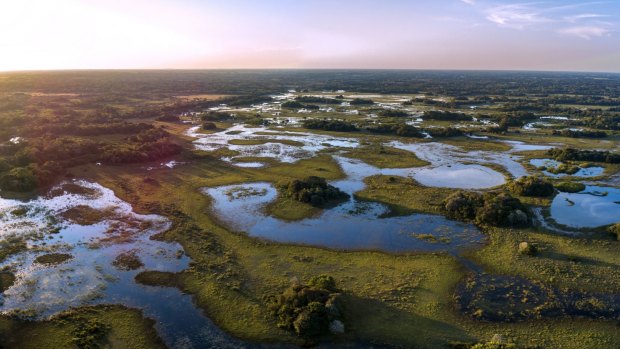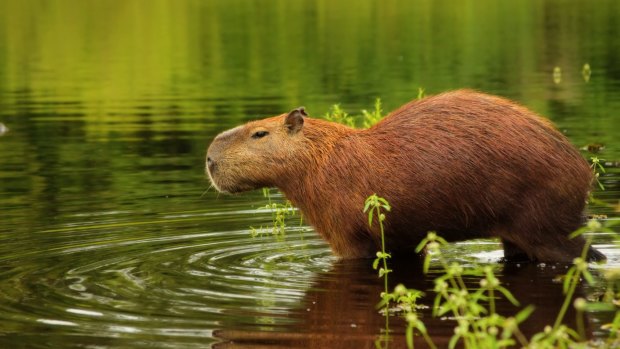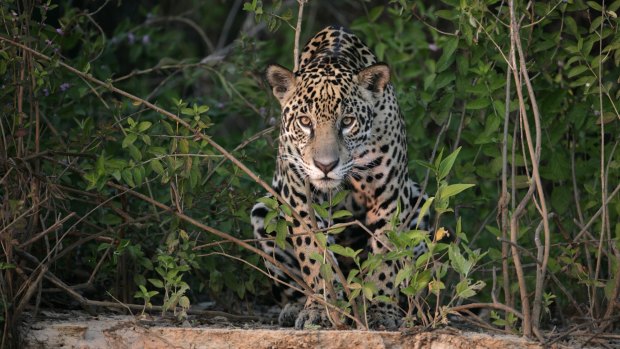This was published 4 years ago
The world's largest tropical wetlands, in the Pantanal, Brazil: A natural wonder you've never heard of
By Rob McFarland

The Pantanal is a UNESCO World Nature Heritage site and Biosphere Reserve in Mato Grosso do Sul, Brazil.Credit: iStock
Rita grins as she turns the wheel and we plunge into another flooded channel. The Land Rover lurches precariously to the right and a wave of water surges up and over the bonnet. She accelerates hard and the vehicle squirms and slides as it scrabbles for grip in the mud. For the tenth time in as many minutes, I'm convinced we're not going to make it. The jeep tilts further to the right, the water now within touching distance through the window. I take a deep breath and brace myself for the roll. But, of course, we don't. The channel shallows, the back wheels find purchase and we emerge unscathed onto a raised grass plateau before repeating the whole nerve-shattering ordeal once again.
Rita has spent her life criss-crossing these farms and knows every trail, dip, bump and hump. Frequently, we come to a watery dead-end – our path blocked by a submerged field too deep to cross, so she backtracks and finds another route. Later, I ask her if she ever gets nervous driving in such treacherous conditions. "No!" she says. "It's an adventure!"
We're in the Brazilian portion of the Pantanal – the world's largest tropical wetlands. Don't worry if you've never heard of it. Before this trip, I hadn't either. Essentially, one vast flood basin, it extends for 210,000 square kilometres across western Brazil, Bolivia and Paraguay. That's 10 times the size of the Florida Everglades.

The world's largest rodent, the capybara, in the Pantanal wetlands.Credit: iStock
Part of the reason it's not as well-known as Brazil's other big natural drawcard – the Amazon – is that only five per cent of it is public land. The rest is comprised of about 2500 privately-owned fazendas (farms), which use the fertile land to graze more than 8 million cattle.
The other challenge is access. There are only two roads in and out, and during the wet season (November to March), about 80 per cent of the Pantanal is underwater. During this time, many fazendas are only accessible by plane. We're here in early November, before the worst of the rains, but already many of the tracks are impassable.
Given these logistical challenges, why bother coming here at all? Because the Pantanal harbours an astonishing diversity of wildlife, including more than 650 species of birds, 159 types of mammals and 98 different reptiles. Birders flock here to see the hyacinth macaw (the world's largest macaw) plus a list-ticking frenzy of parrots, herons, jacanas and tinamous. Other drawcards include jaguars (best seen in the northern half of the region) and an assortment of peculiar creatures including anteaters, tapirs, armadillos and capybaras (the world's largest rodent).

A jaguar in the shrubs.Credit: iStock
Our adventure started two days ago with a backside-numbing six-hour drive from the city of Campo Grande – the main access point for the southern half of the Pantanal. After 150 kilometres of tarmac, we spend two hours on a raised dirt road, then veer onto a rutted track that crosses six farms.
When we eventually pull into Baia das Pedras, Rita is waiting for us, along with a petting zoo of pigs, chickens and dogs. This 15,000-hectare cattle ranch has been in her family for five generations, ever since the first pioneers occupied this land in the late 1800s. She's been welcoming guests for 15 years, one of a handful of fazendas that supplement farming with tourism.
After a restorative glass of fresh cashew juice, we follow Fino, our guide from Bravo Expeditions, into the backyard. As soon as he opens the gate, we're hit by a tsunami of sound – an aural assault of squawks, shrieks, tweets and whoops. Perched in the tall palms is a colourful flock of parrots, macaws, toucans and other birds. Some of the calls are truly bizarre – there's a witch-like cackle, an elaborate looping whistle and one that sounds uncannily like a hippo grunting.
As we venture out into the fields, Fino spots and reels off birds so quickly I have trouble taking them down – yellow-chevroned parakeet, buff-necked ibis, red-shouldered macaw, black cormorant. We see the Pantanal's striking emblem, a 1.5-metre-high jabiru stork, followed by an acrobatic guira cuckoo that's deftly catching insects mid-air. As we approach a gate, Fino points out a pair of pocket-sized burrowing owls, who regard us from neighbouring fence posts with withering indifference.
Back at the fazenda, we embark on what becomes an entertaining daily ritual – ticking off the birds we've spotted from a list of 400 commonly found in the region. I've never considered myself a birder, but this soon becomes one of my favourite parts of the trip. There's good-natured banter among our group as we recap what we saw (and claim we saw) and where.
Fino, of course, has seen them all. After working on farms for 10 years, from the age of 13, as a "peao" (cowboy) , he decided to pursue his love of wildlife and retrain as a guide. As a cowboy, he'd sometimes be away for 28 days straight, camping out with the cattle. "Life is better now," he says, smiling.
We get to see his horsemanship skills the next day when we join a horseback safari around the property. He suggests following him through the submerged ditches so his horse disturbs any caimans (small crocodiles) or green anacondas lurking in the water. I don't argue. The green anaconda is the world's largest snake (more than nine metres long, in some instances) and the Pantanal has the planet's highest concentration of caimans – estimated at 10 million. Thankfully, we don't stumble across either on this outing, although someone does spot a smaller yellow anaconda coiled up tightly in the shallows.
Between excursions we retire to the comfortable lodge where we're fed extravagant amounts of food by Rita and her husband, Carlos. Breakfast is a sprawling buffet of eggs, fruit, cereals and homemade breads while lunches and dinners range from catfish with rice, beans and cauliflower cheese to an authentic "churrasco" of tender steak barbecued over an open fire.
After two days, we leave Baia das Pedras for the hair-greying transfer to Barra Mansa Lodge, a homey six-room property overlooking the Negro River. Rita delivers us into the welcoming arms of Guillermo and Renato, who soothe my frazzled nerves with a potent caipirinha. By Pantanal standards, Barra Mansa is tiny – only 1000 hectares – but it's unique in that it offers access to a diverse range of landscapes, including forests, lagoons, rivers and salt lakes.
Over the next three days, we explore them all – by jeep, horseback, boat, foot and canoe. We have a rare sighting of a tapir crossing the river and a magical encounter with a noisy group of giant otters. We spend an hour observing a giant anteater dig up fire ants and watch with delight as a nine-banded armadillo trots jauntily alongside our jeep. Once again, the birding is exceptional. Much of this is due to Fino's expertise and infectious enthusiasm, but I still get a genuine thrill every time we – okay, mostly he – spots something new.
The transfer back to Campo Grande is another organ-jumbling endurance test. As we leave this watery wonderland, the avian soundtrack of shrieks, tweets and whistles is abruptly replaced by the grating clamour of traffic and horns.
Just as I'm about to pack away my newfound twitching skills, we pass a roundabout in the city centre and there, standing nonchalantly on a grass verge, is a tiny burrowing owl. It's something I'd never have noticed a week ago, let alone known what is was. Fino would be proud.
FIVE MORE NATURAL WONDERS IN BRAZIL
CHAPADA DOS VEADEIROS
Famous for its towering waterfalls and glittering quartz rock formations, this 65,000-hectare national park north of Brasilia also has jaguars, armadillos and toucans.
BONITO
Located 260 kilometres west of Campo Grande, this eco-tourism hub boasts a lush landscape of lakes, waterfalls and gin-clear rivers.
LENCOIS MARANHENSES
This spectacular national park near Sao Luis on Brazil's northeast coast is a photographer's dream – a dramatic combination of towering sand dunes and eye-popping emerald lagoons.
CHAPADA DIAMANTINA
A trekking mecca, this national park six hours inland from Salvador is an epic landscape of plunging canyons, turquoise lakes and majestic waterfalls.
SACO DO MAMANGUA
Located 260 kilometres southwest of Rio, Brazil's only tropical fiord flows inland for eight kilometres, creating a haven for hikers and paddlers.
TRIP NOTES
FLY
LATAM flies to Campo Grande from Melbourne and Sydney. See latam.com
TOUR
Pantanal specialist Bravo Expeditions can create a tailor-made itinerary including accommodation, transfers and English-speaking guides. See bravoexpeditions.com
MORE
Rob McFarland was a guest of Bravo Expeditions and the Adventure Travel Trade Association (adventuretravel.biz).
Sign up for the Traveller Deals newsletter
Get exclusive travel deals delivered straight to your inbox. Sign up now.